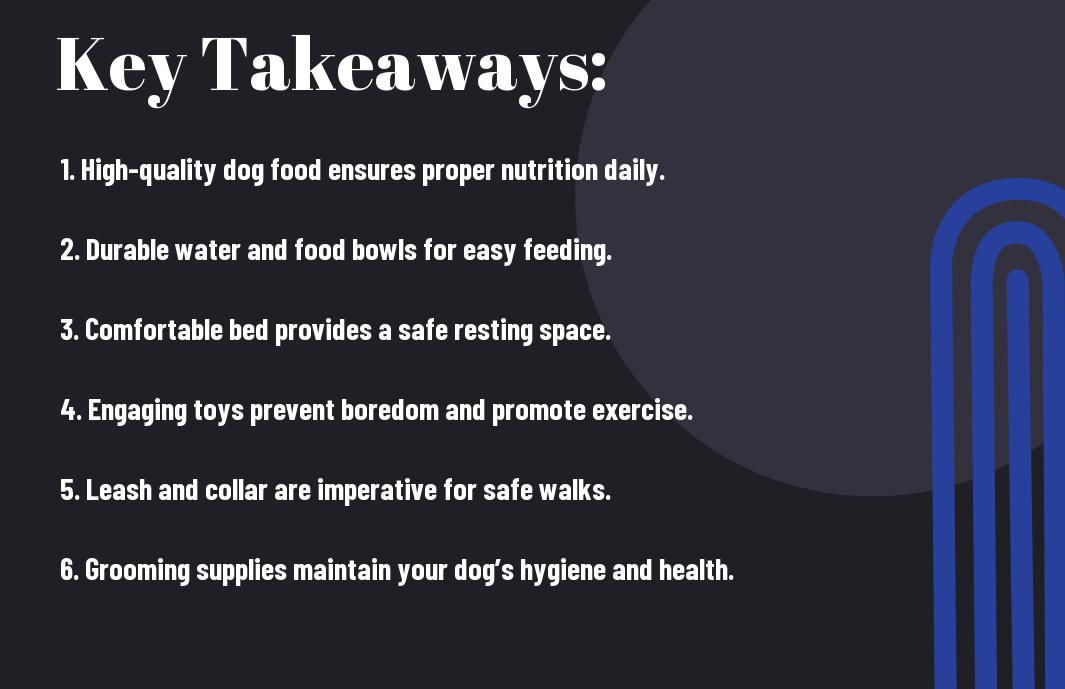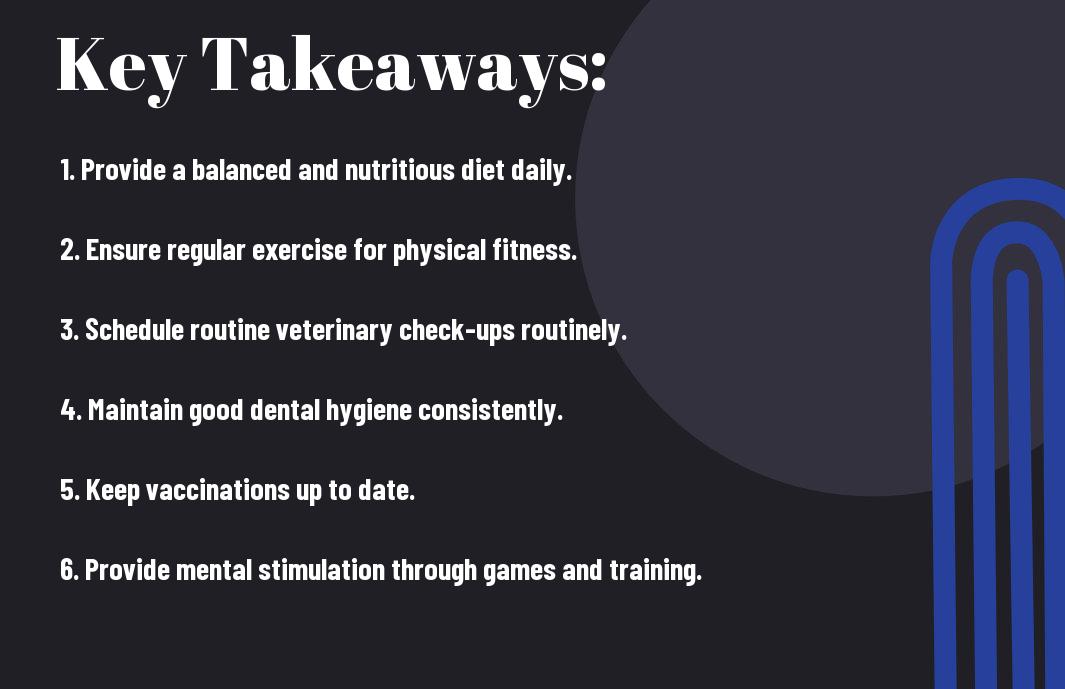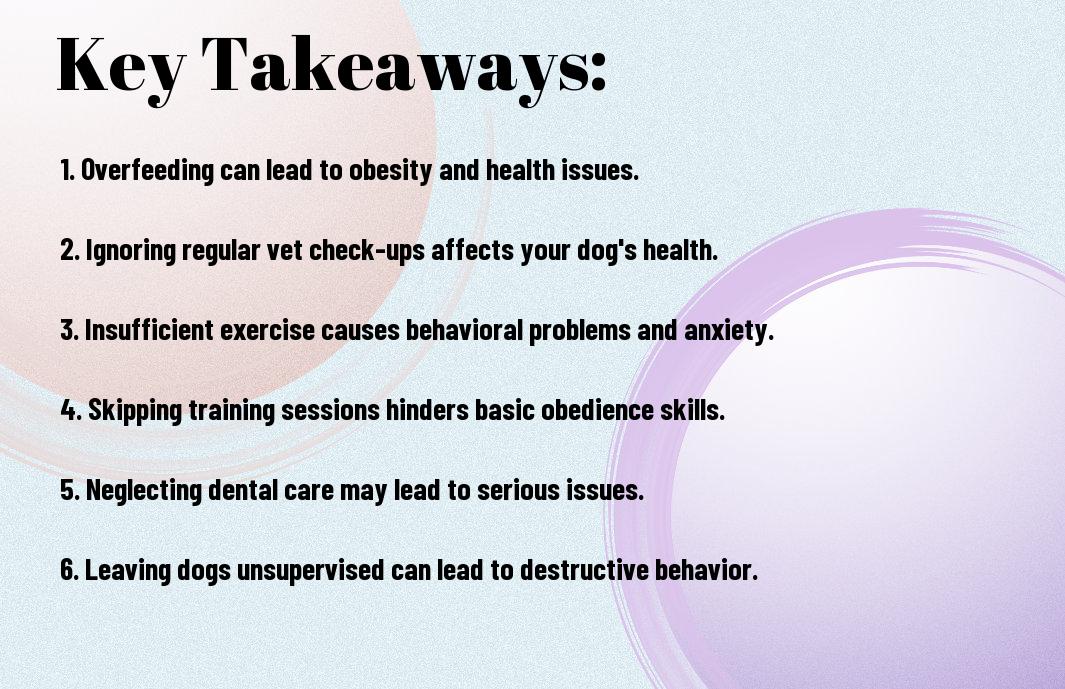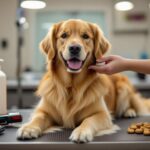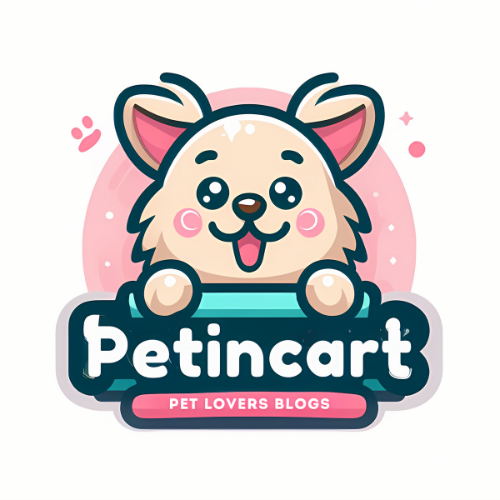There’s a lot to consider when grooming your dog, and even small missteps can lead to significant issues. Whether you’re a seasoned groomer or just starting out, it’s imperative to be aware of common pitfalls that can affect your pet’s health and appearance. In this list, you’ll discover the top 10 dog grooming mistakes to steer clear of, ensuring your grooming experience is safe and effective for your furry friend. Let’s dive in and help you elevate your grooming game!
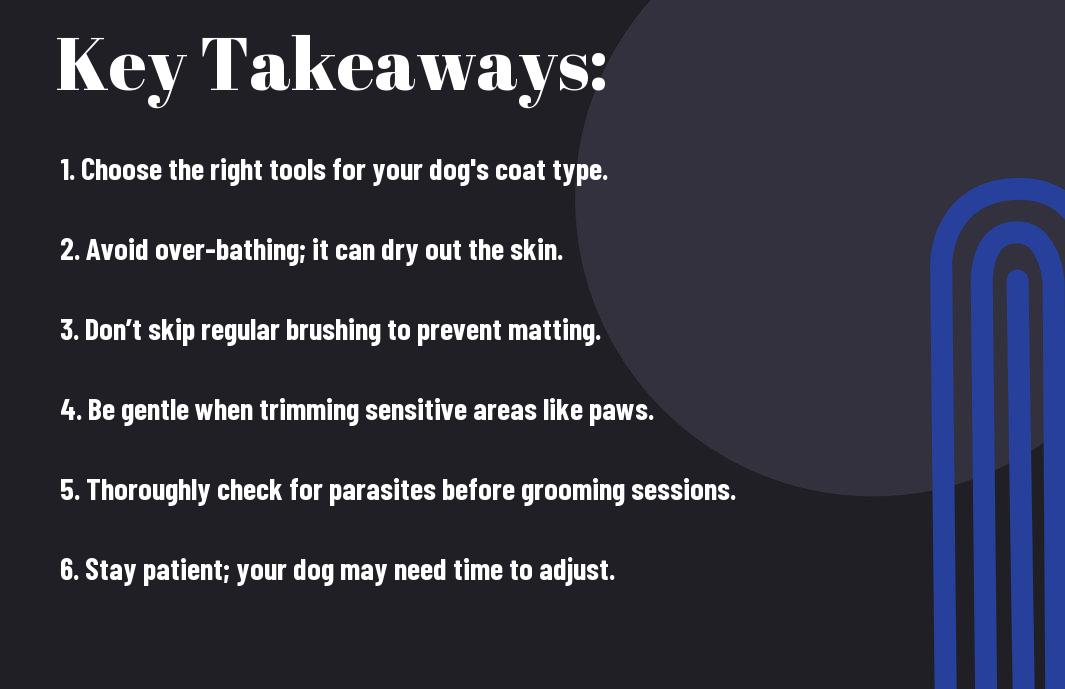

Skipping Regular Grooming
While it may be tempting to skip routine grooming sessions, neglecting this necessary task can lead to a host of problems for your furry friend. Regular grooming is not only about keeping your dog looking good; it plays a vital role in their overall health and hygiene. If you let grooming slide, you risk encountering serious issues that can affect your dog’s well-being and comfort.
Leads to Matting
To maintain a healthy coat, regular grooming is a necessity, especially for long-haired breeds. When you skip grooming sessions, your dog’s fur can become tangled and can eventually develop into mats. These mats can pull at your dog’s skin, causing discomfort and pain. Moreover, they make it difficult for you to detect skin issues, parasites, or underlying health problems that may need attention. The longer you wait to address matting, the tougher it can become to remove, often requiring professional help that could have been avoided with regular grooming.
Unpleasant Odors
To ensure that your dog smells fresh and clean, regular grooming is necessary. When grooming is neglected, dirt, oils, and other debris accumulate in your dog’s coat, leading to unpleasant odors that can linger in your home. A furry friend that smells bad not only affects your dog’s quality of life but can also create an unwelcoming environment for you and your guests. Frequent baths and brushings remove these unpleasant elements, allowing your dog’s natural scent to shine through instead of the buildup of odor-causing substances.
The importance of regular grooming extends beyond maintaining a pleasant smell. Without proper grooming, you may find your dog developing skin irritations or infections due to trapped moisture and debris. Ensuring that your dog stays clean and well-groomed is necessary for minimizing these risks and contributing to their overall health and happiness.
Using Incorrect Tools
It is important to use the right tools for grooming your dog, as incorrect tools can lead to discomfort and even injury. Many pet owners might overlook the importance of having the appropriate brushes and clippers, which can ultimately affect the quality of the grooming experience for both you and your furry companion. Investing in quality grooming tools is key to achieving the best results while also keeping your dog happy and healthy.
Improper Brushes
On your journey to keep your dog looking its best, choosing the wrong type of brush can have a significant impact. Each dog breed has different coat types that require specific brushes for optimal grooming. For instance, long-haired breeds benefit from slicker brushes, whereas short-haired dogs may require rubber-bristled brushes to remove loose hair effectively. Utilizing an improper brush not only leads to ineffective grooming but can also cause discomfort, making your dog apprehensive about future grooming sessions.
Dull Clippers
Now, let’s talk about another common mistake: using dull clippers. When your clippers are not sharp enough, they can tug at the dog’s hair rather than cleanly cutting it, which may result in unnecessary pain or stress for your pet. Dull blades can also lead to uneven cuts, which can ruin the overall look you’re aiming to achieve. It’s worth checking the condition of your clipper blades regularly to ensure they are sharp and well-maintained.
The maintenance of your clippers can make a world of difference when it comes to the grooming process. Dull clippers can cause you to exert more pressure, which may intimidate your dog or cause skin irritation. To enhance your grooming experience, ensure that you sharpen or replace blades as needed and oil your clippers regularly to keep them in optimal working condition. By doing so, you will not only improve the quality of your dog’s grooming but also make it a more enjoyable bonding experience for both of you.
Ignoring Nail Care
All pet owners should recognize the importance of nail care in their dog’s grooming routine. Overgrown nails can lead to several issues that affect not only your dog’s comfort but also their overall health. Regular trimming is necessary to prevent complications, so staying diligent with your dog’s nail care should be part of your grooming checklist. If you overlook this necessary aspect, you may face the consequence of your dog experiencing discomfort during daily activities.
Overgrown Nails
Clearly, overgrown nails can create a host of problems for your dog. When nails grow too long, they can curl and press against the paw pads, leading to pain and potential injury. Moreover, excessive nail length can affect your dog’s natural gait, causing them to walk awkwardly. Regularly checking and trimming your dog’s nails will not only keep their paws healthy but will also help maintain their mobility and quality of life.
Painful Walking
On top of that, overgrown nails can result in painful walking or even limping, which could deter your dog from engaging in play and exercise. This discomfort often manifests slowly, making it easy for you to overlook until it becomes a larger issue. If your dog seems reluctant to walk or exhibits signs of pain when putting weight on their paws, it’s time to take a closer look at their nail length and overall paw health.
It is beneficial to establish a regular nail care routine to prevent painful walking and promote your dog’s well-being. You can either learn how to do it yourself with proper tools and techniques or consult a professional groomer or veterinarian for help. Ensuring your dog’s nails are kept at a manageable length will lead to a happier and healthier pet, enabling them to enjoy walks and playtime without discomfort.
Bathing Too Often
Your dog’s grooming routine is vital for their health and wellbeing. However, one common mistake many pet owners make is bathing their dogs too often. While you might think that more frequent baths keep your furry friend clean and smelling fresh, it’s important to understand that over-bathing can lead to various skin issues. Knowing how to balance cleanliness with natural skin health is vital for every dog owner.
Skin irritation
There’s a delicate balance when it comes to dog grooming, and bathing them too frequently can disrupt this balance, leading to skin irritation. Bathing removes not only dirt but also the natural oils that protect your dog’s skin. When these oils are stripped away, your dog may experience dryness, flakiness, or even inflammation. Signs of skin irritation can include excessive scratching, redness, or the development of hotspots, all of which can be distressing for your dog.
Losing natural oils
You may be unaware of the vital role that natural oils play in your dog’s skin health. These oils provide a protective barrier against environmental irritants and help keep your dog’s skin moisturized. Bathing too often can lead to a significant loss of these beneficial oils, putting your dog at risk for dry skin and other dermatological issues. It’s vital to consider the type of shampoo you use as well since harsh ingredients can further exacerbate the problem.
To ensure that your dog’s skin remains healthy, try to limit baths to a frequency that aligns with their specific needs, usually no more than once a month unless they get particularly dirty. If your dog enjoys outdoor activities, opt for spot cleaning instead of full baths. Additionally, consider using mild, pet-safe shampoos that preserve natural oils and consult with your veterinarian for personalized grooming recommendations tailored to your dog’s breed and skin type.
Not Checking Ear Hygiene
After grooming your dog, one of the imperative aspects to check is their ear hygiene. Regular inspections can prevent a host of issues that could arise from neglecting this area. Dogs with floppy ears are especially susceptible to ear problems, as their ears can trap moisture and dirt. By maintaining a habit of checking your dog’s ear hygiene, you ensure they remain comfortable and healthy, which in turn contributes to their overall well-being.
Wax Buildup
One of the most common ear hygiene issues is wax buildup. Just like humans, dogs produce earwax, but if not monitored, this wax can accumulate and create a breeding ground for bacteria. It’s important to visually inspect your dog’s ears regularly. If you notice excessive wax or a change in color, this may indicate a problem. Routine cleaning can help keep the ear canals free from blockages and ensure that they don’t develop adverse symptoms, such as a foul odor or discomfort.
Infections Risk
Some dogs are more prone to ear infections, particularly those with hairy or floppy ears. When the ears are not cleaned properly, it can result in trapped moisture and oxygen, leading to an ideal environment for bacteria and yeast to thrive. Frequent infections can cause your dog pain and distress, and may require veterinary intervention, including medications or more invasive treatments if left unchecked. By proactively checking and cleaning your dog’s ears, you can significantly reduce the risk of infections and maintain your dog’s comfort and health.
Hygiene is paramount when it comes to your dog’s ear care. Be aware of signs like itching, shaking of the head, or an unpleasant smell, as these can indicate an infection. Keeping a routine ear cleaning schedule and utilizing appropriate cleaning solutions can help prevent your dog from suffering from painful ear issues. Regular check-ups with your veterinarian can further ensure that any potential problems are caught early, safeguarding your pet’s ear health.
Neglecting Teeth Cleaning
Many pet owners tend to overlook dental hygiene when it comes to grooming their dogs. This often leads to a range of issues that can significantly impact your dog’s overall health and well-being. Just like humans, dogs require regular dental care to prevent unpleasant smells and potential health problems. Establishing a routine that includes brushing your dog’s teeth can greatly enhance their quality of life and noticeably reduce bad breath.
Bad Breath
Clearly, bad breath is one of the most evident signs that your dog’s dental hygiene may need some attention. This condition, often referred to as halitosis, can arise from the accumulation of bacteria in your dog’s mouth due to plaque buildup. Furthermore, neglecting your dog’s dental needs can result in an unappealing odor that not only bothers those around your pet but may also indicate underlying health issues that require immediate attention.
Dental Diseases
Now consider the more serious impact of neglecting your dog’s dental care, which can lead to various dental diseases. Conditions such as periodontal disease, gingivitis, and tooth decay can develop when plaque and tartar are left untreated, affecting not only your dog’s teeth and gums but also their overall health. The inflammation and infection from such diseases can cause pain, tooth loss, and even systemic issues if bacteria enter the bloodstream.
You can significantly reduce the likelihood of these dental diseases through consistent brushing and routine veterinary check-ups. Regular cleanings can help keep tartar and plaque at bay, and your vet can provide professional cleanings and assessments to spot potential issues early on. Additionally, incorporating dental treats and toys can support your dog’s oral hygiene, ensuring that their teeth and gums remain healthy and strong.
Overlooking Skin Issues
Not paying attention to your dog’s skin can lead to bigger problems down the line. While grooming, you may notice slight changes in your pet’s skin, such as rashes or redness, that could indicate underlying issues. These signs should not be ignored, as they are often early indicators of allergies, infections, or other dermatological conditions that may require veterinary attention. Regularly inspecting your dog’s skin during grooming can help you catch these issues before they escalate, ultimately saving your pet from discomfort and you from costly vet bills.
Rashes or Redness
An irritated patch or a sudden appearance of redness on your dog’s skin could be a sign of a rash that might result from various causes, including poor hygiene, heat, or exposure to irritants. When you groom your dog, take a moment to feel around areas such as the belly, underarms, and in between the toes, where such problems often arise. If you observe any unusual bumps, scabs, or lesions, it’s important to seek advice from your veterinarian, as prompt treatment can prevent infections or prolonged discomfort for your pet.
Allergies Undetected
To ensure your dog stays healthy, you must be aware of the signs and symptoms of allergies. Some dogs can develop allergies to food, pollen, pet dander, or even certain grooming products. As you groom your dog, look out for frequent scratching, biting, or paw-licking behaviors that might indicate allergic reactions. If your dog is constantly uncomfortable, it can lead to skin infections and other complications if not addressed promptly.
Any signs of allergies that you overlook during grooming can lead to ongoing discomfort for your dog. Regular grooming sessions provide a perfect opportunity to assess your dog’s skin and fur condition. If you notice any allergy symptoms, a visit to the veterinarian can help. Your vet might recommend specific treatments or dietary changes to alleviate your pet’s suffering, ensuring they remain a happy and healthy part of your family.
Rushing the Process
To achieve the best results in dog grooming, taking your time is important. Rushing through the grooming process not only compromises the quality of your pet’s coat but can also increase the stress levels of your furry friend. It’s easy to fall into the trap of hurrying, especially if you have a busy schedule or if your dog is showing signs of impatience. However, the time you spend grooming is not just about aesthetics; it is an opportunity to bond with your dog, check for skin issues, and maintain their overall health.
Stress for Dog
You’ll notice that many dogs may become anxious or agitated when they sense that you’re hurriedly grooming them. This anxiety can surface in various ways, including panting, whining, or trying to escape. A relaxed grooming session is vital for creating a positive experience for your pet, making them more cooperative in the long run. Dogs thrive on routine, and when you take your time, they come to associate grooming with a calm and nurturing experience rather than one filled with pressure.
Poor Quality Results
For many pet owners, rushing through grooming can lead to unsatisfactory results, such as an uneven coat, missed mats, or improperly trimmed nails. You want your dog to look their best, but cutting corners can turn your grooming session into a frustrating experience. The inconsistency and issues that arise from hasty grooming could mean regular visits to a professional groomer, costing you more time and money in the long run.
Poor grooming practices not only affect your dog’s appearance but can also have practical implications for their health. Neglecting proper techniques due to rushing can lead to skin irritations, painful tangles, and even injury. Taking your time ensures that every aspect of grooming is addressed, resulting in a healthier coat and a happier dog. Make it a point to allocate sufficient time for each grooming session, allowing you to focus on quality over speed.
Lack of Patience
Keep in mind that grooming your dog isn’t just about getting the job done; it’s a process that requires your full attention and patience. If you rush through the grooming session, you may create an environment of stress for both you and your pet. When you become frustrated by their squirming or reluctance to cooperate, this negative energy can ripple through the grooming process, leading to further anxiety. Taking a deep breath and allowing ample time for each grooming task will ensure that both of you remain calm and focused.
Frustration increases
Patience is key in transformative grooming experiences. When frustration levels rise, mistakes are more likely to occur, whether it’s nicking their skin while clipping their nails or missing tangles in their fur. You need to approach the task with a composed mindset, as your dog can sense your emotions. If you find yourself getting annoyed, take a step back and reassess the situation. Break the grooming process into smaller, manageable segments to help you maintain your composure and avoid overwhelming your furry friend.
Fearful reactions
To foster a positive grooming experience, it’s necessary to recognize that your dog’s hesitation or fearful reactions are often a reflection of your own attitude towards the grooming process. If you are impatient or stressed, your dog may perceive this as a threat, heightening their anxiety and reinforcing negative behaviors. By approaching grooming with a calm demeanor, you encourage a sense of security, making it easier for your pet to relax and cooperate.
A patient approach to grooming allows you to create a safe environment for your dog, minimizing the likelihood of fearful reactions during the process. Engaging in positive reinforcement is an effective way to build confidence; offering treats, praise, and affection can help counter any initial fears your dog may have about grooming tools or techniques. By gradually introducing them to the grooming routine, you help establish trust, enabling a smoother and more enjoyable grooming experience for both you and your pet.
To wrap up
The mistakes you make while grooming your dog can significantly impact not only the appearance of your pet but also their health and comfort. By avoiding the common pitfalls discussed, such as neglecting regular grooming, using inappropriate tools, or mishandling sensitive areas, you can ensure a more pleasant experience for both you and your furry friend. Proper grooming techniques not only keep your dog looking good but also promote a healthy coat and skin, as well as a strong bond between you and your pet.
Ultimately, being informed about the top 10 dog grooming mistakes empowers you to make better choices during grooming sessions. By honing your skills and implementing the best practices, you can transform grooming into a positive experience. Your attention to detail will lead to a happier, healthier dog, and that’s the ultimate goal of any loving pet owner.
